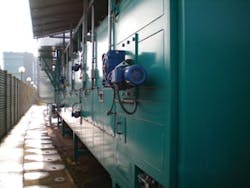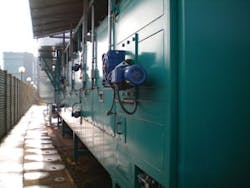Project SAGE: Safeguarding the water supply
• Researchers at the UA's Water Village are working to ensure ways to prevent contamination of our water supply
By Lew Serviss
Aug. 26, 2009 -- In a one-room building within an easy walk of the Tucson International Airport terminal, Ryan Sinclair, a research associate in the department of soil, water and environmental sciences, watched red dye disperse through a matrix of pipes.
As the dye coursed through a four-way junction, Sinclair, grad student Alex Andrave and senior Mario Mondaca turned to a computer screen. A high-speed camera trained on the junction relayed 1,000-frame-a second images.
"Is it all going to turn to the right or is it going to mix totally uniformly?" Sinclair asked. "What they assumed for the last hundred years is there's a phenomenon called complete mixing, that it completely mixes at each junction and that's something that they're looking at down there. It doesn't happen like that, of course, if you have high flowing water and slow flowing water. The high is going to dominate."
The goal is to determine where the contaminant is flowing and how to contain it.
The lab is one element of the Water Village on the campus of the Environmental Research Lab next to the airport. In the Point of Use Laboratory nearby, Jaime Naranjo, principal research specialist, tests water filters designed for homes in the developing world. "Essentially, what they do is take the filter, put it on a wall in their houses" and pour the water through it.
"We have seeded the water with organisms," Naranjo explained. "What we want to see is how efficient is the system to remove the pathogens" -- polio and rotoviruses, and parasites like giardia and cryptosporidium.
"Water quality issues are a problem all over the world," said Charles Gerba, professor of soil, water and environmental science and microbiology and immunology.
Gerba, a leading expert in domestic and public hygiene and a longtime investigator of public-health outbreaks, sees the nature of water safety changing. "The whole idea of water is changing, too, from treating now to controlling it in the distribution system. There are organisms that can tolerate the chlorine and the disinfectants. They're growing in the distribution system."
Another part of the Water Village -- the Water Sensor Laboratory -- addresses that risk. A wall of the lab is covered with assorted real-time monitors built to detect chemicals and pathogens.
"The big question is, with organisms, there's no quick method to measure them," said Sinclair.
"You always have to either take a sample, look at it in the microscope or grow it on media, and those are really time-consuming events."
BioSentry is a laser-based system that shoots a laser through a column of water as a digital camera records the resulting shadows.
"What happens is the shadow will be moving constantly and then when it becomes a certain shape, then it knows there's a certain particle moving through. So it can recognize different types of shapes and different sizes," Sinclair said. "It will recognize rod-shaped bacteria, which are e-coli, other vegetative bacteria, and it will recognize cryptosporidium-shaped things, spores, cysts. Any kind of categorized thing."
It builds a baseline, and when it moves beyond that baseline, an alarm goes off.
"It's really the art of predicting what the risk is," said Gerba. "With water, how many people are going to get sick and die and how can we reduce that number?"
"In water it's really how they disperse," he said. "These problems are very complex. You have to have modelers, math people, engineers, microbiologists, sensor technology people."
###

